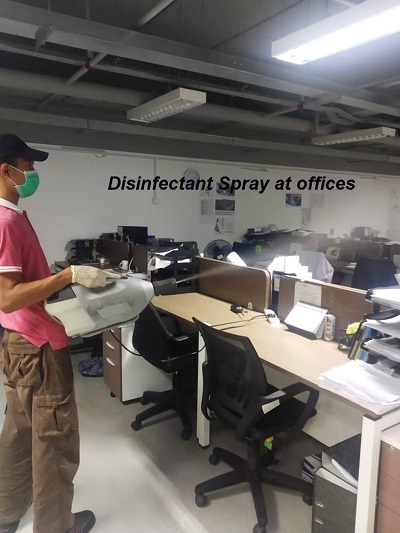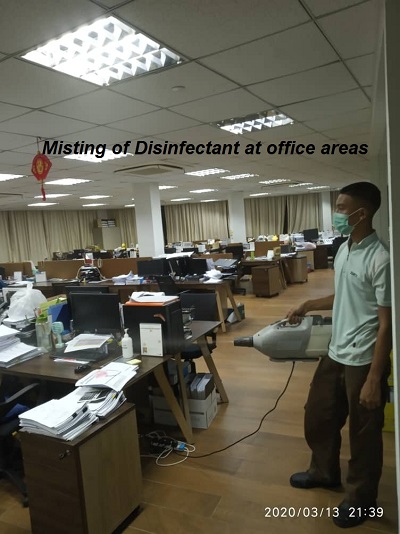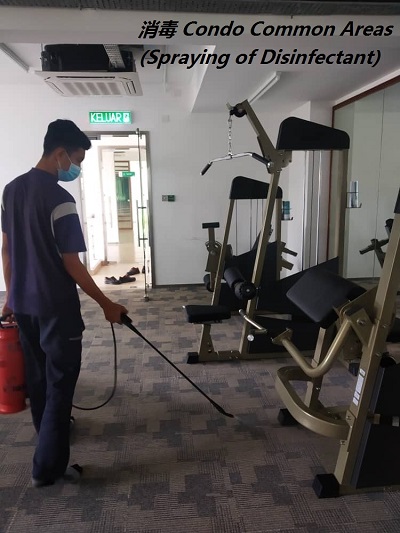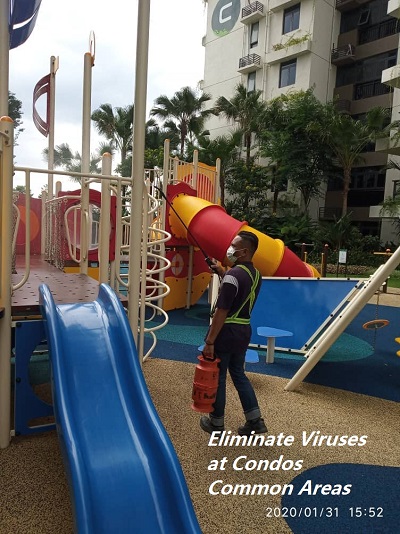



How our Disinfection Service to be done?
Ultra Low Volume (ULV) Misting disinfection is dispersed into the air and every corner. It produces super fine droplets of our chemical which is designed to destroy bacteria and viruses in exposed areas.
Our chemical with Benzalkonium Chloride effective against Coronaviruses. It destroys the envelope protein that surrounds some virus, including Coronaviruses.
Chemical recognized by WHO (World Health Organization)
1) Eliminates 99.9999% of germs and viruses
2) Remove bacteria from your premise with direct treatment, air-borne bacteria/ viruses
?3) ULV Misting disinfectant solution into the air.
4) Alcohol Free (Suitable for enclose area)
5) Responsible action to take during pandemic outbreak
Anti-bacterial disinfectant will reduce 99.99% of bacteria and viruses in the air and surface. We offer decontamination and disinfection services for the following:
- Commercial Buildings
- Offices
- Hospitals
- Polyclinics
- Laboratories
- Childcare & Schools
- Manufacturing Plants
- Residential Premises.

Sani-Spray
(13.03.2020)
��
1. Sani-spray ��
Sani-spray �㧹5 (Dialdehyde and Benzalkonium choloride)����
Sani-spray �� (lysine protein) (arginie amino acid) () ��
2. Sani-spray
Sani-spray �� ()��99.9999%
��99.9911,00010,0001000

Integrated Pest Management (IPM/HACCP)
Reporting, Documentation & Follow Up
All necessary report and documentation will be submitted accordingly once the job was confirmed.
- Bait station layout & Chemical spraying layout (HACCP defined area)
- Rat monitoring report & General service report
- Chemical List of MSDS
- Legal document & license (Company & technician license)
- Quarterly Professional pest progress & pest trend analysis report
What is HACCP?
HACCP - an acronym for Hazard Analysis and Critical Control Points - involves a seven-step process to protect our nation's food supply:
- Analyze hazards. Potential hazards associated with food and measures to control those hazards are identified. The hazard could be biological, such as a microbe; chemical, such as a pesticide; or physical, such as ground glass. Of particular concern to PCOs and sanitarians are pests that are capable of transmitting food borne pathogens (i.e., cockroaches, flies).
- Identify critical control points. These are points in a food's production - from its raw state through processing and shipping to consumption by the consumer - at which the potential hazard can be controlled or eliminated. Examples are cooking, cooling, packaging and metal detection.
- Establish preventive measures with critical limits for each control point. For a cooked food, for example, this might include setting the minimum cooking temperature and time required to ensure the elimination of any microbes.
- Establish procedures to monitor the critical control points. Self explanatory.
- Establish corrective actions to be taken when monitoring shows that a critical limit has not been met. For example, reprocessing or disposing of food if the minimum cooking temperature is not met, placing the public at risk to food borne pathogens transmitted by pests.
- Establish procedures to verify that the system is working properly. For example, testing time and temperature recording devices to verify that a cooking unit is working properly.
- Establish effective recordkeeping to document the HACCP system. This would include records of hazards and their control methods, the monitoring of safety requirements and action taken to correct potential problems.
Definition of IPM: Integrated Pest Management (IPM) is a decision-making process that anticipates and prevents pest activity and infestation by combining several strategies to achieve long-term solutions. Components of an IPM program may include education, proper waste management, structural repair, maintenance, biological and mechanical control techniques, and pesticide application.
| QUESTIONS | ANSWERS |
| How does IPM differ from traditional pest control? | IPM employs an approach that requires more participation by the factory to achieve long-term pest control. |
| What does ''integrated'' mean? | The use of two or more pest management techniques (Inspection, Identification, Sanitation, Cultural, Mechanical, Biological and/or Pesticides) to achieve established pest management objectives. |
| What does an IPM service involve? | An IPM service requires time and effort to: inspect and monitor pest activity; employ procedures; make suggestions for eliminating points of entry and resting areas; and deter potential pest infestations and/or reduce existing ones. |
| What is your responsibility as a Factory Manager in an IPM program? | Your continuous involvement and participation are needed to implement your pest control technician's recommendations for an effective program. |
| What is habitat modification? | Factories have different micro habitats which provide food, water, and harborage for pests. Decreasing the availability of suitable habitats for pest and denying access into the premise may control infestations. |
| Does IPM eliminate the use of pesticides? | An effective IPM program may include the use of pesticides. However, the amount needed will likely be reduced. |
| When pestiides are used, how are they applied? | The appropriate use and application of pesticides are spelled out by the PESTICIDES ACT 1974 (amended 2004). Fog Master supervisors will tell you where and how pesticides will be applied in or near your premise. |
IPM Steps
- Inspection
- Identify Pests and Conducive Conditions
- Prevention
- Customer Consultation
- Sanitation, Exclusion and, if necessary, Pesticide Application
- Evaluation
- Monitoring
IPM Benefits
- Pest Prevention
- Customer Awareness
- Less Reliance on Pesticides
- Improved Home Maintenance
- Long-Term Solutions
- Precise Pesticide Application
- Effective and Environmentally Sensitive Protection







